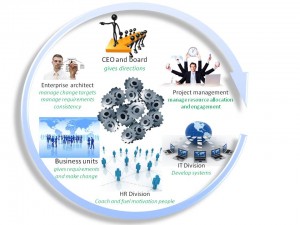Successful Solvency II programs have opened the doors to enterprise architecture
 Solvency II regulatory initiative aims to normalize the way Insurance companies will measure risks, will manage their portfolio in accordance and will report on their record to control authority.
Solvency II regulatory initiative aims to normalize the way Insurance companies will measure risks, will manage their portfolio in accordance and will report on their record to control authority.
Such a big change may lead companies to reorganize their steering processes : some driven by internal momentum willing to get market differentiators, some others driven mainly by regulatory constraint. Whatever the vision, this will end up with major business transformations and, for some companies, with industry recombination due to portfolios optimization.
Hopefully, most of companies have launched transformation programs and, as Deloitte reports in its 2011 survey, more than 52% of UK companies had reached implementation phase by 2011 with 75% among big companies. Moreover the same report shows that budgets are expected to be contained between 1,2m and 12m euros, larger amounts being intended only for biggest organizations.
But, if boards seem to be aware of Solvency II new responsibilities and opportunities, projects and programs still undergo uncertainties and questions :
- on capital calculation methods which still have to be tuned and for some of them fullly specified
- on data which have to be collected, processed, checked and validated for each calculation method
- on organization which have to get responsibilities of subprocesses and define how they intend to performe them
- on management which have to prepare people and to request investment for resources
Finally, companies undergo 2 opposing forces : strong dependancies between Solvency II aspects and fragmentation forces coming from solving approach which have been selected to deal with complexities : technical (actuary, computing, business,…) and social (actors, governance, influence,…). Technical fragmentation comes from necessity to adopt partial analytical approach. Social fragmentation comes from business mindset, culture, influence competition.


![Riskprojects1[1]](http://capirossi.org/wp/wp-content/uploads/2013/01/Riskprojects11-300x225.png)







